Brooding of Great Tits
Source: http://www.bingo-ev.de/~kh3515 - researcher: Klaus Haber
Abstract
The activities of a pair of great tits have been followed, from the start of the egg laying until the fly out of the young ones from the nest. The electronically collected measuring data, e.g. the number of visits to the nest in different periods, nest temperature compared to the outer temperature, number of feedings etc., have been put in graphs and discussed. Off course the conclusions from the observations are only valid for the observed pair of tits. Although likely, it is not proven that great tits in general behave the same.
1. Introduction
Tits are very active vermin (caterpillars, bugs, spiders) fighters, especially during the growing up of the young ones. I was interested to see how often the young ones in the nest are fed. After all the number of visits to the nest (feedings) makes it possible to draw conclusions about the fighting of vermin.
In an accessible tree in our garden a great tit nestbox is hanging already for many years. Next to it is a garden shed - with electrical power connection - for gardening tools. These two, the nestbox and the shed, were the starting point for my experiment.
2. Nestbox
The nestbox was of the usual type, that means made of wood with a removable front. To record the visits to the nestbox some device with an electrical contact was needed. On the one hand this device should not disturb the birds, on the other hand it should give a reliable contact at the entrance of a bird to the nestbox. I decided to use a microswitch, that I tuned to a sensitivity of 6 grams. A great tit weighs about 10 grams, thus this guaranteed a sure activation of the switch. I enlarged the entrance opening in the front of the nestbox and mounted the microswitch on the inside (to protect it against rain) in such a way that, with a tilt board over it, an electrical signal was obtained every time a bird slipped in or out the nestbox. For each visit 2 signals were thus obtained, this has been taken into account when calculating the number of visits. To activate the switch a movement of 2 mm was needed. The construction ensured that the original size of the entrance opening was restored and that the birds were not irritated by an alteration.
When the nest was completed, but before the first egg was laid, I built in an electronic thermometer (Pt100, about 5 mm long) in the upper layer of the nest. Both devices, the signal switch and the thermometer, were connected with thin wires to suitable recorders in the garden shed.
3. Recording equipment and execution of the measurements
The microswitch was connected with an electro-mechanical counter, and apart from that with a paper recorder. The counter was reset every night. The recorder was set to make a spike on the paper at every activation of the switch, and was running constantly during the whole measuring period. The thermometer was connected to a temperature converter, that activated a second paper recorder. The aim of this equipment was to obtain not only the number of nest visits per day, but also get insight into the division over the whole day. With the temperature measurement it should be determined which temperature was reached in the nest during the brood.
4. Number of nest visits
As stated earlier, the nestbox was good accessible. When the parent birds were not there, I could easily inspect it. In the whole experiment the main aim was not to disturb the birds and not hinder them in their activities.
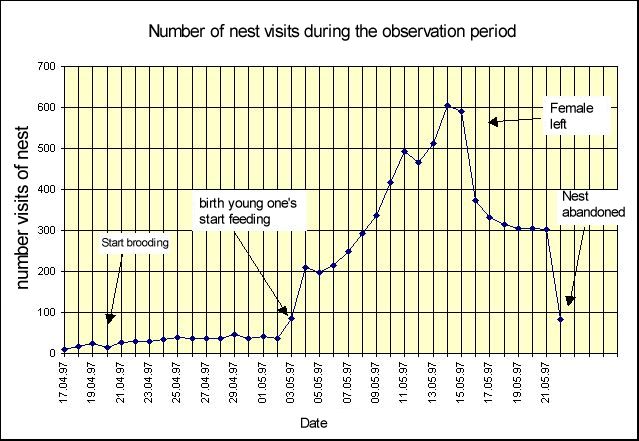
Figure 1: Number of nest visits during the observation period
After 13 days the young birds came out of the shell. During this time the male and female bird together entered and left the nestbox about 40 times per day. The male came more often to feed the brooding female. On the 13th day a sudden increase of the visiting frequency in the nestbox was observed, an indication that the eggs were hatched. The feeding activity started, and the parent birds got a tough job! In the next 12 days, the feeding frequency increased dramatically to 600 (!) visits per day. An indication for the increasing need for food of the growing young birds. Then something happened that I could first not understand. Even more dramatically than the rise of the feeding frequency, the amount of feeding visits decreased. I observed the nestbox from a sheltered position and saw that only the male bird came to feed the young ones. The female stayed away and I have never seen her again. She might have been grabbed by a predator or perished. And now something astonishing happened: the feeding frequency of the male decreased even further over the next days, and stabilized at 300 nest visits per day. I concluded from it that male and female both spent an equal amount of work on feeding of the young birds. Or in different words, male and female have fed equally many, both about 300 times per day in the busiest days. This although I expected that the female should care more about the brood than the male. 32 days after the start of brooding the young birds have left the nest, within a span of a few hours only. It was very clear that the male suddenly stopped feeding. This, together with calling by the male in front of the nestbox, encouraged the young birds to leave their home. By the way, one young bird did not survive, he was lying dead in the nest in an already considerably grown up state.
I had never expected that the male should manage to raise the brood successfully on his own. I can not exclude that, when the female had not died, the young ones would not have flown out a day earlier, as from the moment that the male fed on his own each young bird statistically got only half of the amount of food.
Much later I read in a research article about mono- and polygamy of birds, that especially tits are polygamous. Thus, did the female possibly not perish but did she take another lover? If so, what a bitch!
5. Nest visits during the brooding
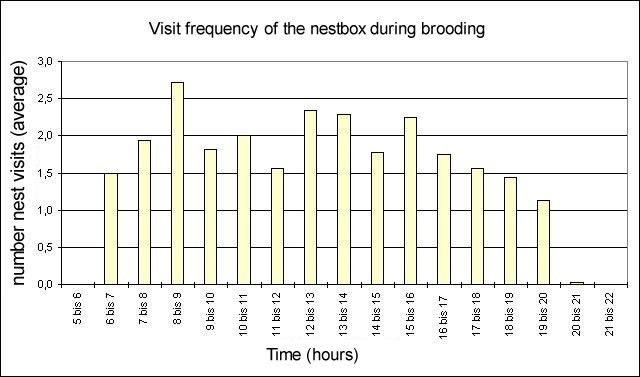
Figure 2: Visit frequency of the nestbox during the brooding
It can be seen from the graph that the activity of the tits started between 6 and 7 in the morning during the brooding. Between 8 and 9 and another time between 12 and 16 hours the female went out herself to look for food and "stretch her legs". During the brooding she was fed by the male, but at most 2 times per hour. This means that the female sits rather steady on the nest and leaves it only seldom.
6. Nest visits during the raising of the young birds
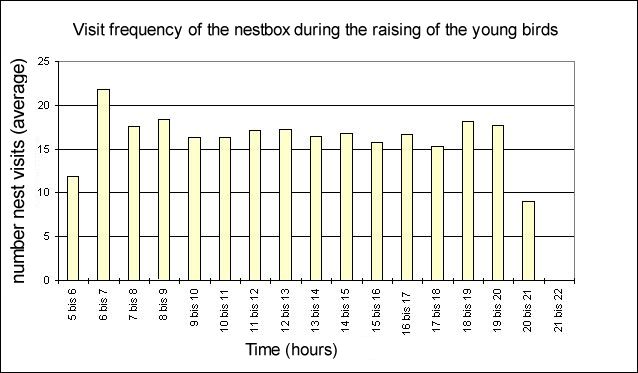
Figure 3: Visit frequency of the nestbox during the raising of the young birds
This graph shows clear differences compared to figure 2. First the day already starts 1 hour earlier for the tits, at 5 o'clock. You can see that the nestbox is visited about 15-20 times per hour, the brood continuously requires food! The maximum activity is in the period from 6-9 hours, and another time between 18 and 20 hours. Looking from the human viewpoint I would say that the young birds have the greatest appetite early in the morning after a night without food, and in the evening their tummies are filled once more by their parents to come through the night. But probably it is not exactly like this. It is possible that in these peak hours nature offers the largest amount of food, and that the birds react on this. For sure there is nothing like a lunch break in the nestbox. The figure shows further that the feeding is, with exception of the stated periods, rather even over the whole day.
7. Wake and sleep time
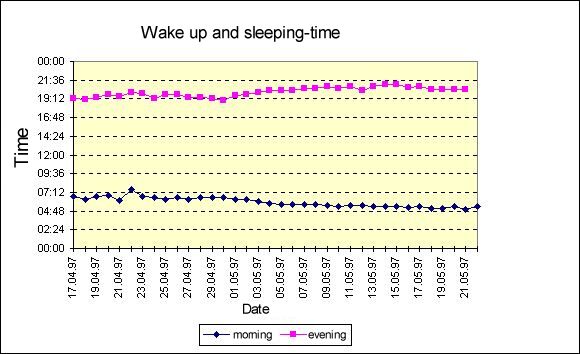
Figure 4: Wake and sleep time of the tits
The observation period was in April/May and lasted 34 days. In this time the length of daylight increased. The tits also followed this trend of nature, resulting in earlier waking up and later going to bed. Unfortunately this is not very clear in the graph because of the somewhat awkward vertical scale. The difference is about 1 3/4 hours in the morning and 11/4 hours in the evening.
8. Temperature in the nest
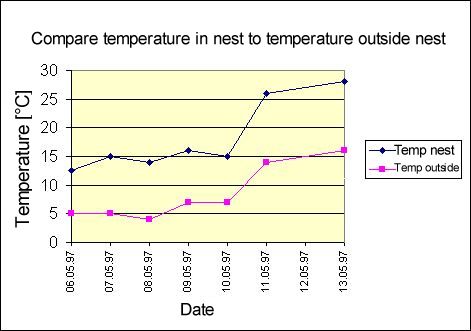
Figure 5: Temperature in the nest
Although the temperature inside the nest was continuously recorded during the observation period, the outer temperature was only read now and then. It is interesting to see that, almost independent of the temperature outside, the temperature inside the nest was always between 8 and 12 degrees higher in this period. However, we can not say that the temperature in the nest is almost constant. The temperature registration with the Pt100 was that accurate, that I could see within 15 seconds if the female had just left the nest or just returned. Her absence on the nest was always so short, that the decrease in temperature of the nest was never more than 2 °C.
Source: http://www.bingo-ev.de/~kh3515 - Researcher: Klaus Haber
Remarks of Madelen Essens:
In 2003 I have done my own research on tits. Differences compared to this work are:
- The female left the nest during the brooding about 1 time per hour, on average for 15
minutes each time.
- 4 to 1 day before flying out I have counted how often feed was brought in between 5.30
and 8 hours: on average 47 times per hour. There were 9 youngsters in the nest.
- From the moment that the young birds were 14 days old, the female did not sleep inside
the nestbox anymore.
- Flying out of the young birds was after 21 days and 4 hours.
- The first young bird flew out of the nestbox without being called by the parents. When
the parents observed this youngster they started to call the others.
- Although there were still 3 young birds inside the nestbox, the parents left with 6
youngsters. The last 3 birds left the nestbox on their own occasion, and are most probably
not taken away by the parents.
[ Home ] [ overview birdhouses ]